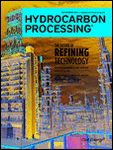I have no direct involvement in the oil refinery. However, I was a process engineer in an edible refinery plant before for quite some time. I had a really good taste of experience working in the refinery plant before. I strongly believe that if a chemical engineering student or a new chemical engineer wants to gain experience, he or she should work in a refinery. This is mainly because they will learn and apply all that they have learn in chemical engineering.
Edible Oil Refinery
Edible oil originates from crude oil such as crude palm oil (CPO), crude soya bean oil (CSBO), crude rape seed oil (CRSO), crude coconut oil (CCO) and so on. Edible oils have very high content of free fatty acids (FFA) and needs to be refined before using as cooking oil. However, the refinery process isn't only limited to remove FFA, it also removes the undesired components such as moisture, color and odour which may trigger negative impact on the final taste, odour and appearance of the oil product. The resultant oil is thinner without fatty acids, colorless and odorless.
It is imperative to note that the edible oil refinery can be divided into 2 primary types namely, chemical refining and physical refining. This time, I'll explain about the chemical refining plant.
Chemical Refining Plant
Chemical refining plant involve neutralization of crude oil by removing fatty acids. This is always referred to as chemical refining or sometimes Neutralizing process and its plant referred as Neutralizing Plant (NP). In this process the oil is neutralized in the neutralizer to remove the fatty acids by mixing with caustic soda (sodium hydroxide). Oil is heated up to roughly 60oC by and oil is stirred by stirrer. The fatty acids are settled at the bottom as alkali soaps which is called soapstock from where it is taken out into soap tank .

Neutralized oil is passed through the second vessel called bleacher where color of oil is removed by bleaching process with the help of chemicals such as carbon black and bleaching clay. Oil is usually heated up to 110oC. Stirring is also carried on. Bleaching process is done under vacuum. Bleached oil then goes to filtration process where bleaching clay and chemicals are removed and cleaned.
Removal of unpleasant smell
Bleached oil is then passed through deodorizer where oil is heated above 110C and then live steam clean is used to the oil from the bottom steam nozzles. The temperature of oil is raised up to 200 to 220C through thermic fluid coils. Entire process is done under high vacuum. Thus smell is removed from the oil in the deodorizer. Then it goes to cooler where cold water circulating coils take away heat and oil is cooled.
Final Filtration
Final filtration is performed after cooling down the oil. This operation is carried out in a micro filter closet or filter bag/filter cartridge which makes the final edible oil termed as refined edible oil. This final filtration process is designed for more effective filtration and best quality of final refined edible oil. There are certain refineries that adopted Hazard Analysis Critical Control Point (HACCP) to completely ensure that the oil is free and safe to be consumed.

Update: As a process engineer or production engineer in a plant (such as this chemical / physical refining plant), you need to know, be prepared and keep stock of all spare parts and engineering equipments (especially during shut downs or turn around). WDS Component Parts has been quite helpful in that area. They supply a vast array of top quality parts, and their website is really cool because it is easy to navigate – which is especially useful when you’re looking for something particularly obscure.
"Don't buy solar panels. Instead, Build them - like they did!" Watch the FREE video presentation NOW and discover…
- Why you should run like hell from $10,000 and $20,000 retail solar panel systems
- A little known way to slash your electric bill by 80% or more (or even get off the grid entirely)
- How a “technologically retarded” guy stumbled on a way to generate free energy with homemade solar panels
- A simple, 5-step process for building your own low-cost solar panels
- And how to say “goodbye” to the electric company… and “hello” to clean, FREE electricity!
-------------------------------------------------------------------
FREE Recommended magazines to get you updated with current engineering news



 Have you downloaded my free "Choosing Alternative Fuel" Ebook? If not, then please download it here. It's Free and on top of getting the free ebook, you'll get eCourse on Alternative Fuel. It's a good and easy way to add more valuable information to yourself.
Have you downloaded my free "Choosing Alternative Fuel" Ebook? If not, then please download it here. It's Free and on top of getting the free ebook, you'll get eCourse on Alternative Fuel. It's a good and easy way to add more valuable information to yourself.



